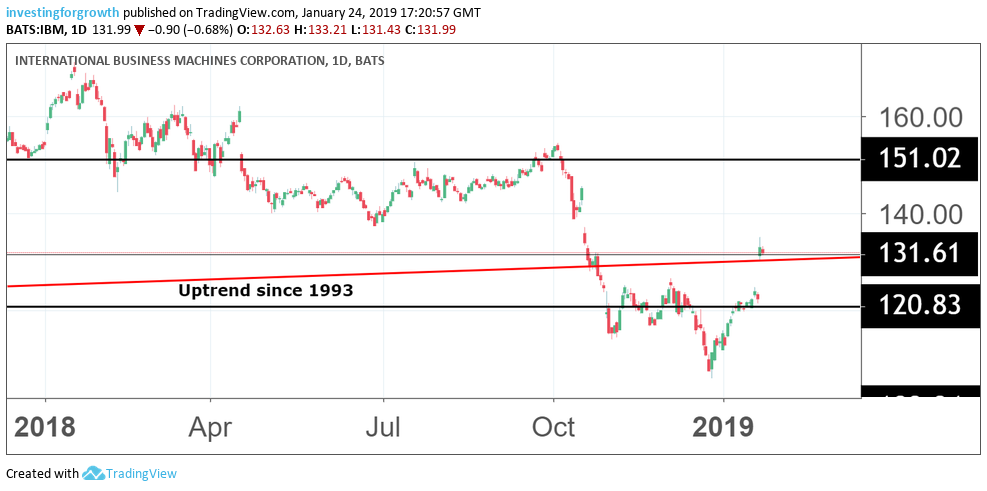Stockwatch: The tech share I want to own
25th January 2019 10:06
by Edmond Jackson from interactive investor
Find out why our companies analyst would rather buy this cheap, high-yielding IT behemoth than Microsoft.

This last week has seen a reality check for the outbreak of investor optimism since Federal Reserve officials changed tune to a more flexible monetary stance, and hopes arose for a US/China trade deal – teased along by President Trump's tweets.
A mid-Tuesday 400-point drop in the Dow Jones index didn't just reflect fears that trade talks had hit rocks though. It's the wary outlook in companies reporting, once results appeared after Martin Luther King Day - Stanley Black & Decker (NYSE:SWK) came in ahead of expectations for Q4 2018 but guided earnings forecasts down for 2019, albeit less than 3%, citing margin pressure and cautioning on revenues also.
"As we enter 2019, the external challenges don't magically disappear," it said. "There are signs that the global economic growth is slowing and that the US economy may soon be coming to the end of one of the most enduring recoveries in US history."
Similarly, healthcare conglomerate Johnson & Johnson (NYSE:JNJ) topped Q4 expectations, but anticipates lower revenue; this is significant because healthcare is often promoted as defensive for equity portfolios, as if for peace of mind opt for bonds or cash.
Capital One Financial (NYSE:COF) upheld the mixed profile of banks reporting which I highlighted last week. It missed its revenue target, swinging from loss to profit albeit lower than expectations, and revealed a 29% jump in credit write-offs.
Regarding consumer sentiment, London-listed Burberry (LSE:BRBY) cited weak footfall in the US where it derives about a quarter of its revenues, and December data for US existing home sales fell to the lowest level in three years.
A redeeming feature is consumer goods multinational, Procter & Gamble (NYSE:PG), whose stock jumped nearly 5% to $95 on Q4 2018 profit up 28%, with planned price increases yet to kick in; while rival Kimberly-Clark (NYSE:KMB) cited lower Q4 revenue/profit due to higher commodity prices and currency swings.
A dilemma for buying into Proctor & Gamble however is a price/earnings (PE) multiple around 25 times and yield of 3%, so defensive qualities look priced in, while the stock is exposed to any deterioration in its narrative or another market de-rating.
- Sound rationale for buying US bank shares
- Two of the best investment possibilities for 2019
- How to trade FAANG stocks this earnings season
US Q4 reporting is shaping up with broadly decent numbers albeit a wary outlook, with no end in sight to a US government partial shutdown liable now to be hurting the economy. Trade talks look – at best guess - as if some kind of compromise will be struck enabling both sides to save face, while still tackling what the US dubs as decades of state-coordinated Chinese theft of American intellectual property.
Mind how a great many stocks in the UK – small to big cap alike – have charts resembling those in the US: late 2018 falls followed by a New Year rebound. Plenty remains to be seen to judge intrinsic value in this fluid environment.
IBM: moving to a new phase of growth?
Back in the 1990s I recall meeting at Smith & Nephew (LSE:SN.) AGMs an eclectic if a tad eccentric, retired doctor sporting a large pink bow tie. Maybe just the chap to make astute contrarian investments, he explained how he'd bought keenly into International Business Machines (NYSE:IBM) after its performance plunged, then made big profits from the subsequent overhaul as the stock soared from about $15 to peak around $200 in 2012.
Since then, however, IBM has seen a bear market down to $110 last December, amid lacklustre financials and a need to better position for growth. The current chief executive has been in charge since 2012 and, in early 2017, finally turned the corner on six years of revenue decline. That compares with Microsoft (NASDAQ:MSFT) whose share price went parabolic from 2012 as it capitalised both on new hardware and software/cloud innovations.

Source: TradingView (*) Past performance is not a guide to future performance
IBM's Q4 2018 saw a 3.5% revenue slip to $21.8 billion, said due to a weak phase in the mainframe computer cycle where this business plunged 44% in Q4 versus 71% growth a year before. Systems revenue also fell 21% to $2.6 billion. Earnings per share (EPS) of $4.87 was down 5% like-for-like but slightly ahead of consensus, and management guided for 2019 EPS of $13.90 versus $13.81 (on a normalised basis) for 2018.
On the face of it, nothing to inspire, but the stock rebounded 8.5% to $133 in response as investors warmed to the story in a context where a recent PE sub-10 times compares with Microsoft on 44 times trailing earnings. Even now, IBM trades just below 14 times earnings for 2018 and, if dividend forecasts are born out, its yield rises from 4.7% to 6.3%.
We might not get too excited about that in a UK stock market context, but in the US it stands out. Effectively, these big tech groups are converging on a similar space of services, cloud and analytics.
Chief financial officer heralds 'a very important inflection year'
Despite a mixed Q4, it's the first time in some years that IBM has managed to raise annual revenue, operating income and EPS concurrently. That's a bit of a stretch as, in constant currency terms, group revenue was flat at $39.8 billion, although IBM's "strategically imperative" segments broadly met a $40 billion forecast for 2018, made in 2015. Q1 expectations are for a like-for-like revenue decline, although EPS is projected for "at least $13.90" or 6 cents better than the 2019 consensus.
While coming across as marginal changes, remember that this is a $121 billion super-tanker, so don't expect mid-cap dynamics. Potentially, the financials may indicate a turning point even if slow to evidence.
In the results conference call the CFO drew attention to the current $34 billion acquisition of Red Hat (NYSE:RHT), a software group engaged in operating systems, cloud, mobile and storage systems, on a global basis. This to me looks risky in terms of price/value – at $176 a share currently, the market cap is $31.2 billion and trailing PE multiple over 80 times – but IBM envisages synergies.
Indeed, from the results' conference call the CFO cited "an opportunity to lift all of IBM, by selling more of our analytics and artificial intelligence capabilities across multiple platforms. As clients proceed on their journey to get more business value from the cloud, they need more services help, from the digital design to app modernisation etc. Our hand will get stronger with the addition of Red Hat, which positions us as the leader in hybrid, multi-cloud world."
Forecasts, where IBM's free cash flow is expected to remain steady at around $12 billion with strong conversion from earnings, exclude any contributions from Red Hat given uncertainties as to exact timing of the deal closing – its 2018 results show $279 million net income and $905 million.
| International Business Machines Corp | ||||||
|---|---|---|---|---|---|---|
| Annual financial results | Revenue: $million | Gross Margin: % | ||||
| 2017 | 2018 | 2017 | 2018 | |||
| Segment | ||||||
| Cognitive Solutions | 18453 | 18481 | 78.6 | 77.5 | ||
| Global Business Services | 16348 | 16817 | 24.9 | 26.7 | ||
| Technology Services and Cloud Platforms | 34277 | 34462 | 40.3 | 40.5 | ||
| Systems | 8194 | 8034 | 53.2 | 49.8 | ||
| Global Financing | 1696 | 1590 | 29.3 | 29.1 | ||
| Other | 171 | 207 | ||||
| Total: | 79139 | 79591 | 46.7 | 46.4 | ||
Not the recovery the doctor ordered, but still a 'buy'
IBM's current situation is far from its 1990s drama, but I note key factors to suggest attractive risk/reward. Despite rebounding on the results, IBM shares' earnings rating and yield price in a good element of risk: you would have to envisage serious integration problems with Red Hat, to reckon on much downside.
True, IBM has shown itself a slowcoach wresting revenue gains and arithmetic isn't on the side of a big cap like this to deliver growth. More sets of results are needed to affirm consistent progress. But, if management can continue reasonably to deliver on its strategy, on a two-year view prospects weigh to the upside both for earning and their rating.
Given a choice, on current information I'd rather own IBM than Microsoft. The stock's easing to about $131.50, as the market renewed frets over Chinese trade talks, shows how patience will be a virtue in the current fragile environment. Accumulate.
*Horizontal lines on charts represent levels of previous technical support and resistance. Trendlines are marked in red.
Edmond Jackson is a freelance contributor and not a direct employee of interactive investor.
These articles are provided for information purposes only. Occasionally, an opinion about whether to buy or sell a specific investment may be provided by third parties. The content is not intended to be a personal recommendation to buy or sell any financial instrument or product, or to adopt any investment strategy as it is not provided based on an assessment of your investing knowledge and experience, your financial situation or your investment objectives. The value of your investments, and the income derived from them, may go down as well as up. You may not get back all the money that you invest. The investments referred to in this article may not be suitable for all investors, and if in doubt, an investor should seek advice from a qualified investment adviser.
Full performance can be found on the company or index summary page on the interactive investor website. Simply click on the company's or index name highlighted in the article.
Disclosure
We use a combination of fundamental and technical analysis in forming our view as to the valuation and prospects of an investment. Where relevant we have set out those particular matters we think are important in the above article, but further detail can be found here.
Please note that our article on this investment should not be considered to be a regular publication.
Details of all recommendations issued by ii during the previous 12-month period can be found here.
ii adheres to a strict code of conduct. Contributors may hold shares or have other interests in companies included in these portfolios, which could create a conflict of interests. Contributors intending to write about any financial instruments in which they have an interest are required to disclose such interest to ii and in the article itself. ii will at all times consider whether such interest impairs the objectivity of the recommendation.
In addition, individuals involved in the production of investment articles are subject to a personal account dealing restriction, which prevents them from placing a transaction in the specified instrument(s) for a period before and for five working days after such publication. This is to avoid personal interests conflicting with the interests of the recipients of those investment articles.